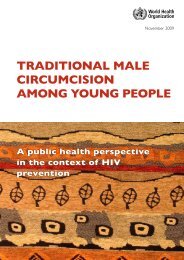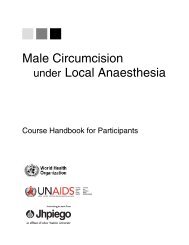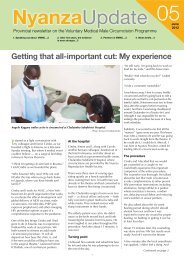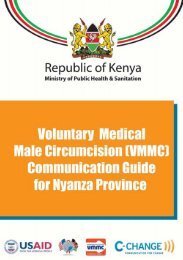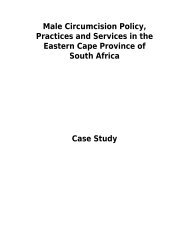Manual for Male Circumcision under Local Anaesthesia
Manual for Male Circumcision under Local Anaesthesia
Manual for Male Circumcision under Local Anaesthesia
Create successful ePaper yourself
Turn your PDF publications into a flip-book with our unique Google optimized e-Paper software.
<strong>Male</strong> circumcision <strong>under</strong> local anaesthesia Version 2.5C (Jan08)<br />
While an HIV test is recommended <strong>for</strong> all men requesting<br />
circumcision to reduce their risk of HIV infection, the test is not<br />
mandatory be<strong>for</strong>e the operation can be per<strong>for</strong>med. No person<br />
should be <strong>for</strong>ced to have an HIV test against his or her will,<br />
and men have the right to refuse without affecting their clinical<br />
care. The purpose of the HIV test is not to protect the clinic<br />
staff from HIV infection – they should, in any case, take<br />
standard precautions to avoid infection with HIV and other<br />
organisms, and to avoid passing such infections from one<br />
patient to another. Men who are found to be infected with HIV<br />
can safely have a circumcision procedure, provided they are<br />
clinically healthy, but there is no point in having a circumcision<br />
to reduce the risk of acquiring or transmitting HIV infection. It is<br />
most important that men with HIV infection take steps to<br />
reduce the likelihood of transmitting the virus to others by<br />
avoiding penetrative sexual intercourse or always using<br />
condoms.<br />
The circumcision team should ensure that the client has been<br />
in<strong>for</strong>med about the risks and benefits of male circumcision as<br />
described in Chapter 3. This in<strong>for</strong>mation should be given in an<br />
<strong>under</strong>standable way, using everyday local language. The oral<br />
in<strong>for</strong>mation should be backed up by written in<strong>for</strong>mation sheets<br />
in the local language. After receiving the in<strong>for</strong>mation the client<br />
should be allowed to ask questions. He should then be given<br />
time to reflect be<strong>for</strong>e being asked to sign the certificate of<br />
consent. An example in<strong>for</strong>mation sheet and consent certificate<br />
can be found in the appendices to Chapter 3.<br />
PREOPERATIVE WASHING BY THE PATIENT<br />
On the day of surgery, the client should wash his genital area<br />
and penis with water and soap, retracting the <strong>for</strong>eskin and<br />
washing <strong>under</strong> it. This ensures that the genital area is clean<br />
be<strong>for</strong>e he comes to the clinic. Immediately be<strong>for</strong>e the<br />
operation, the skin should be further cleaned with povidone<br />
iodine (see Chapter 5).<br />
If the pubic hair is long and likely to get in the way of surgery or<br />
interfere with the dressing, it should be clipped be<strong>for</strong>e the<br />
patient enters the operating room. the patient can do this at<br />
home on the day of surgery, or it can be done at the clinic.<br />
Shaving is not necessary.<br />
The patient should be given the opportunity to empty his<br />
bladder be<strong>for</strong>e going into the operating room.<br />
Facilities and supplies and preparation <strong>for</strong> surgery Chapter 4-7<br />
<strong>Male</strong> circumcision <strong>under</strong> local anaesthesia Version 2.5C (Jan08)<br />
SCRUBBING AND PUTTING ON PROTECTIVE CLOTHING<br />
Be<strong>for</strong>e entering the operating room area, all members of the<br />
surgical team should:<br />
• Remove all jewellery and ensure nails are trimmed or filed.<br />
• Remove any artificial nails or nail polish.<br />
• Wash hands and arms up to the elbow with a nonmedicated<br />
soap.<br />
• Make sure hands and nails are not visibly soiled.<br />
Be<strong>for</strong>e the circumcision operation, anyone who will touch the<br />
sterile surgical field, the surgical instruments or the wound<br />
should scrub their hands and arms to the elbows. Scrubbing<br />
cannot completely sterilize the skin, but will decrease the<br />
bacterial load and risk of wound contamination from the hands.<br />
Each scrub should take 5 minutes, and the process should be<br />
done at the start of the operating session and, if more than one<br />
circumcision is planned, between each operation.<br />
The scrub can be done with a medicated soap and water, or<br />
with an alcohol-based preparation.<br />
Surgical scrub with a medicated soap (Fig. 4.2)<br />
• Start timing.<br />
• Using a medicated soap, scrub each side of each finger,<br />
between fingers, and the back and front of each hand.<br />
• Wash each side of the arms from wrists to elbows.<br />
• Keep your hands higher than your arms at all times during<br />
the procedure.<br />
• Rinse hands and arms by passing them through the water<br />
in one direction only, from fingertips to elbow. Do not move<br />
your arms back and <strong>for</strong>th.<br />
• After scrubbing, hold up your arms to allow the water to<br />
drip off your elbows.<br />
• Turn off the tap with your elbow.<br />
Facilities and supplies and preparation <strong>for</strong> surgery Chapter 4-8





